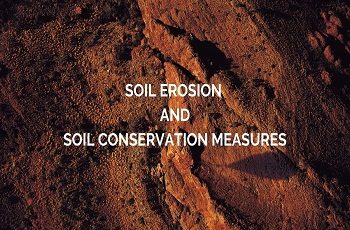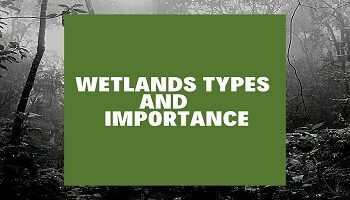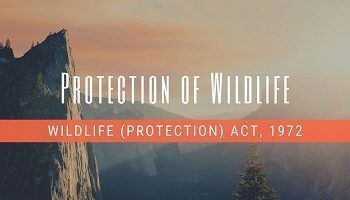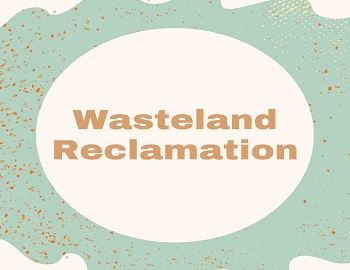Table of Contents
Soil Erosion & Soil Conservation Measures:

What is Soil?
- The surface material covering much of the earth, composed of the minerals, particles, humus, water, air, in which plants can grow is called soil.
- It is the loose material forming the upper layer of the earth’s crust.
- It is formed slowly over a longer period by chemical and mechanical weathering of bedrock.
- About 90% of the soil is composed of inorganic matter.
What is Soil Erosion?
- The literal meaning of soil erosion is wearing away of soil. Soil erosion occurs when the rate of removal of soil by water and or wind exceeds the rate of soil formation.
- Soil erosion is defined as the movement of soil components, especially surface-litter and topsoil from one place to another.
- Soil erosion results in the loss of fertility because it is the topsoil layer which is fertile.
Causes of Soil Erosion:
There are two types of agents which cause soil erosion: climatic agents and biotic agents.
Climatic Agents:
Water and wind are the climatic agents of soil erosion.
Water Erosion:
Sands and silt are the soils which are more prone to water erosion. Water induced soil erosion is of the following types:
Sheet Erosion:
- Sheet erosion is erosion in which the top layer is eroded. Improper ploughing techniques can also lead to erosion. This type of erosion is more prominent on steeper slopes. It is more harmful because it erodes the top layer and renders the soil unfit for cultivation.
Rill Erosion:
- Linear grooves are formed. If erosion due to water continues unchecked for a significant amount of time finger-shaped erosion may happen due to washing away of silt. The rill channels can temporarily be obliterated by tillage. However, tillage loosens the soil making it more susceptible to rill erosion.
Gully Erosion:
- On the other hand in gully erosion, erosion takes place due to rain, etc when the grooves as in rill erosion widen as in Chambals behads. It is a more serious type of erosion. Ravines are formed if Gully erosion is unchecked. It is a more serious problem in areas where rivers flow. It is quite prominent in Banas, Chambal, Narmada, etc.
Slip Erosion:
- This occurs due to heavy rainfall on slopes of hills and mountains.
Stream Bank Erosion:
- During the rainy season, when fast running streams take a turn in some other direction, they cut the soil and make caves in the banks.
Wind Erosion:
Wind erosion occurs in arid and semi-arid areas. Wind erosion is responsible for the following three types of soil movements:
Saltation:
- When soil particle is very fine or medium, wind removes this by carrying it away along with it.
Surface Creep:
- When soil is coarser, it is not carried away by the wind in the air but rolls over the surface and the upper layer is removed.
Biotic agents:
- Excessive grazing, mining, and deforestation are the major biotic agents responsible for soil erosion.
- Due to these processes, the topsoil is disturbed or rendered devoid of vegetation cover.
- So the land is directly exposed to the action of various physical forces facilitating erosion.
Soil Conservation Measures:
In order to prevent soil erosion and conserve the soil the following conservation practices are employed:
Mulching:
- In agriculture and gardening, mulch is a protective cover placed over the soil to retain moisture, reduce erosion, provide nutrients, and suppress weed growth. The harvested fields are covered with litter and crop residue. The stubbles are also kept intact. It prevents the growth of weeds and helps in the retention of moisture.
Contour Farming:
- On gentle slopes, crops are grown in rows across, rather than up and down, a practice known as contour farming. Each row planted horizontally along the slope of the land acts as a small dam to help hold soil and slow down the loss of soil through run-off water.
Terrace Farming:
- These are made on the steep slopes so that flat surfaces are available to grow crops. They can reduce surface run-off and soil erosion.
Alley cropping:
- It is a form of inter-cropping in which crops are planted between rows of trees or shrubs. This is called Agro-forestry. Even when the crop is harvested, the soil is not fallow because trees and shrubs still remain on the soil holding the soil particles and prevent soil erosion.
Strip Cropping:
- Strip cropping is a method of farming used when a slope is too steep or too long, or when other types of farming may not prevent soil erosion.
- Large fields can be divided into strips.
- Different crops with different maturity time are sown so that at no time fields are completely exposed.
- Taller crops break the wind and act as barriers, while smaller crops stem the flow of water and help in retaining the water.
- Alternatively, stripes of fallow lands can be used in areas where the soil is not so fertile, and alternate stripes are sown leaving alternate stripes fallow.
Conservation till farming:
- In the traditional method, the land is ploughed and the soil is broken up and smoothed to make a planting surface. However, this disturbs the soil and makes it susceptible to erosion when fallow (i.e. without crop cover).
- Conservation till farming, popularly known as no-till-farming causes minimum disturbance to the topsoil.
- Here special tillers break up and loosen the subsurface soil without turning over the topsoil.
- The tilling machines make slits in the unploughed soil and inject seeds, fertilizers, herbicides, and a little water in the slit so that the seed germinates and the crop grows successfully without competition with weeds.
- No-till farming has carbon sequestration potential through storage of soil organic matter in the soil of crop fields.
Sand Fencing:
- A sand fence is a type of fence, similar to a snow fence used to force windblown, drifting sand to accumulate in a desired place. Sand fences are employed to control erosion and to recruit new material in desert areas.
Buffer Strip:
- A buffer strip is an area of land maintained in permanent vegetation that helps to control air, soil, and water quality, along with other environmental problems, dealing primarily with the land that is used in agriculture.
Wind Breaks or Shelter Belts:
- In the coastal and dry regions, rows of trees are planted to check the wind movement to protect soil cover.
Thus, soil erosion is one of the world’s most critical problems and, if not slowed, will seriously reduce agricultural and forestry production, and degrade the quality of aquatic ecosystems as well due to increased siltation. Soil erosion is in fact, a gradual process, and very often the cumulative effects become visible only when the damage has already become irreversible. The best way to control soil erosion is to maintain adequate vegetational cover over the soil.








Comments (No)